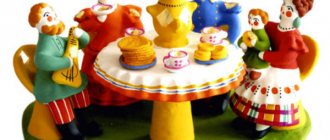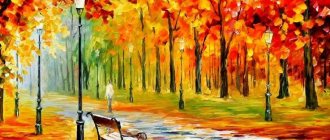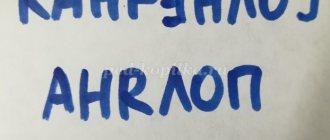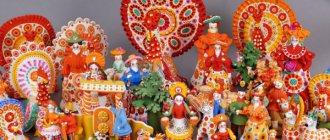Summary of the lesson “Dymkovo toy” for children of the preparatory group
Summary of the lesson “Dymkovo toy” for children 6-7 years old
Author: Naira Igorevna Nersesyan, teacher at MBDOU “General developmental kindergarten No. 144”, Voronezh
Purpose: teachers of senior and preparatory groups, primary school teachers, parents. Goal: Introducing children to folk culture. Objectives: -Introduce the history of the Dymkovo toy. -To cultivate love and respect for the work of folk craftsmen, for the folk art of Russia. -To consolidate children’s knowledge about the process of making Dymkovo toys and the ability to talk about it. -To develop knowledge about the characteristic features of painting toys, the ability to create patterns according to one’s own design. Learn to identify the elements of the geometric pattern of Dymkovo painting (circles, straight and wavy lines, checkered patterns, dots and peas). Learn to paint with Dymkovo patterns. -Develop aesthetic perception, sense of rhythm, color, creativity. Deepen aesthetic knowledge of folk arts and crafts. Preliminary work: drawing up a presentation “Dymkovo toy”, original Dymkovo toys for demonstration, printed stencils on white paper (A4 format) and colored pencils. Lesson plan: - 1. Organizational point 2. Theoretical part.
An introductory conversation about the history and process of creation with a demonstration of Dymkovo toys, paintings, presentations. An explanation of the painting sequence. 3. Final part. Progress of the lesson
Educator: Guys, you all have toys, but what are they made of? Children: Our toys are made of plastic, rubber, metal, wood, fabric. Educator: Let's find out what toys are made in the village of Dymkoye? What is Dymkovo famous for? With his toy. There is no smoky color in it, But there is the love of people. There is something in it from the rainbow, from drops of dew. There is something of joy in her, thundering like bass. (V. Feofanov) Educator: People affectionately and tenderly call this toy “haze.” Where does such an amazing name come from? Let us introduce you to Dymkovo clay toys. I was born in the large settlement of Dymkovo across the river near the city of Vyatka. In ancient times, residents of this settlement, young and old, sculpted clay toys for the spring fair. In winter, the entire settlement is in smoke from the fact that the stoves are heated and toys are burned. On cloudy days, the fog from the river spreads like a light haze. Perhaps this is where the name Dymkoye arose, and the toys began to be called Dymkovo. Dymkovo toys were made for the ancient holiday "Whistling Dance". Later, the fair-festival began to be called "Whistling". What kind of toys are these, let's see? Through the mountain spurs, Through the roofs of villages, A red-horned, yellow-horned clay deer rushes.
Here is a smart turkey, He is all so fine, The big turkey has all his sides painted. Look, his fluffy tail is not at all simple, It’s like a sunny flower, and then there’s the comb.
The Dymkovo young lady is all in orange, gold, scarlet and green patterns.
Look how beautiful this girl-soul is, her scarlet cheeks are burning, her outfit is amazing. Even the horses are in festive outfits.
Clay horses race on stands as hard as they can. And they won’t hold on to the tail if they lose the mane. Educator: What do all these toys have in common? Children: All toys have bright colors, everything is on a white background, covered with beautiful patterns. Educator: What paint do you think the toy is first coated with? Children: White. On a white background, the patterns stand out well and beautifully.. Educator: Can you guess where the masters got the white color from? Children: They took it from the snow, from winter. The toys were made in winter!!! Educator: That's right. The craftsmen took the white background from the snow-covered fields, when in winter everything around is white and white. In those places, the winter is long and there is a lot of snow. The craftsmen want to make the toy as clean and white as snow. Why are they bright?
Children: Because they were made for the holiday, so they painted them with bright colors. Educator: What colors did the masters use to paint toys? Children: They used bright colors: red, blue, crimson, yellow, orange, green. Educator: What patterns do you see on the toys? Children: On the toys there are circles, dots, lines, squares, stripes, curves, waves, squares, rings, ovals. Educator: What images can be seen in Dymkovo toys? Children: Horse, cockerel, deer, ram, young lady. Educator: The most common subjects: nannies with children, water carriers, rams with golden horns, turkeys, roosters, deer and, of course, young people, buffoons, ladies. Educator: Let's find out how a toy is created? (Children watch the video on the interactive board, the teacher talks at the same time). A lot of work must be put into making the toy so elegant. It is born three times. The first time it is born is when it is sculpted from red clay. The figures are sculpted in parts, individual parts are assembled and completed, using liquid red clay as a binding material. The molding marks are smoothed out to give the product a smooth and neat surface. The toy must be burned to make it durable. The intense heat causes the toy to become hot, and when it cools down, the clay becomes ringing and strong. This is how the toy is born a second time. There is a trial by fire. And when is the third time born? Children: The third time a toy is born is when it is whitened and painted. Educator: Then it is whitewashed with chalk diluted with milk and painted. Sometimes pieces of gold leaf are stuck on top of the pattern, which gives the toy even more elegance. This is how it is born for the third time. Beautiful, bright, elegant toys are sold at the fair. Making a toy, from modeling to painting - the process is unique and creative, never repeated. There are not and cannot be two absolutely identical products. Each toy is unique, unique and inimitable.
Educator: I suggest you become real folk craftsmen and paint the stencils of the Dymkovo toy. Printed stencils are distributed to children. They begin to “paint” with pencils with pleasure. In the process of independent work, the teacher provides children with complete creative freedom, providing individual assistance. You can turn on soft folk music. At the end of the lesson there is an exhibition.
We recommend watching:
Lesson with older preschoolers. Dymkovo toy Lesson notes on labor training in 2nd grade Notes of GCD in the middle group. Dymkovo toy Abstract of the GCD for sculpting “Dymkovo toy”. Preparatory group
Similar articles:
Modeling figures from plasticine
Master class for preschool teachers. Dymkovo lady
Lesson notes for the middle group. Dymkovo toy
Tasks.Continue to introduce children to the Dymkovo toy as a type of folk arts and crafts to enrich visual impressions, develop aesthetic feelings and assessments. Draw children's attention to the figurative expressiveness of objects of art. To form ideas about some artistic crafts, knowledge about what materials and tools craftsmen use (to make toys you need: clay, a pottery wheel, a special stick or brush to draw a pattern, a stove to fire the product, special paints for painting).
Preliminary work.
Examination of objects of decorative and applied art, conversation about the fact that all these beautiful things were created by masters - folk craftsmen.
Materials, tools, equipment.
4-5 Dymkovo toys (lady, horse, turkey, ram, etc.), a rotary disk for displaying toys or a stand, decoration for performing a mini-play; didactic manual (table) with characteristic color combinations and decorative elements of the Dymkovo craft. Album for children's creativity I.A. Lykova “Dymkovo toy”.
Contents of the lesson.
The teacher introduces the children to the Dymkovo toy.
Approximate content of the teacher’s story “Toys are not simple - clay, painted.”
— From the high bank of the Vyatka River, on which the city of Vyatka stands, you can see the village of Dymkovo. Why is it called that? In the old days - both in winter, when the stoves were lit, and in summer, when there was fog, this village seemed to be shrouded in haze, everything was in smoke. Here, in ancient times, a toy was born, which was called “Dymkovo”...
In the beginning there were whistles. All winter the women of Dymkovo sculpted them for the fair. From a small clay ball with holes, the whistle turned into a duck, a cockerel, or a skate. And now on the trays and counters of the crowded spring fair they sell cheerful goods. Adults and children willingly take it apart. The whole area resounds with whistling. The people's festivities are noisy, but the loudest sound is the loud whistle. That is why this spring holiday got its name - “Whistling”. A new winter comes, and again in Dymkovo they get down to business. And so on for many, many years. Grandmothers teach their granddaughters, and granddaughters teach their granddaughters.
And in our time, in Vyatka, which is now called Kirov, there are workshops of the famous Dymkovo toys. And they make not only whistles there. If we go into these workshops, we will immediately see piles and bags of clay, boxes of paints, boxes of eggs. All this is needed to create a miracle. Fairytale horses, turkeys that look like firebirds, sheep in pants, ladies and gentlemen, carousels, even stoves - one with Emelya, and the other with kids, and all this is a real miracle.
When you watch a craftswoman at work, it seems that everything is very simple. So she pinched off a piece of clay, rolled it into a sausage, then she took more clay, slammed it into a cake, then she rolled the cake into a funnel - it turned out to be a skirt. She attached a head and arms on top, bent the sausage with a rocker, sculpted buckets, put a tall kokoshnik on her head, and attached a tiny nose. I left the figurine to dry first on the bench and then in the oven.
The figurines that emerge from the oven are hardened, strong, and sonorous. They are whitened with chalk diluted in milk, then they begin to paint. And patterns come out from under the brush: circles, straight and wavy stripes, cells, spots, dots. Everything is in its place and everything burns bright and bright. The colors are crimson, red, green, yellow, orange, blue - colorful and cheerful, like in a round dance!
But it turns out that the work is not finished yet. There is still a lot of gold to be planted. The craftswoman wets the brush in raw egg, lightly touches the golden square or diamond and “plants” it in the right place - for ladies and water bearers on kokoshniks and hats, for roosters - on combs... Now the toys glow and become even brighter.
The teacher creates interest in the Dymkovo toy: he shows three or four figures that came to visit the children, and plays out the emotional dialogue between them. Invites children to look at Dymkovo toys and tell about them what they are like (fun, elegant, bright, beautiful). He reports that in the next classes the children will sculpt and paint Dymkovo toys like real masters.
Conversation on familiarization with folk arts and crafts: “The affectionate word “Haze”
(Senior preschool age)
Goal: to form patriotic feelings and respect for the history of the Russian people through familiarity with the Dymkovo folk toy.
Tasks:
Educational: to cultivate interest in the products of Dymkovo masters. Educational: introduce children to one of the types of folk applied art - the Dymkovo clay toy, the history of its origin, elements of painting, color.
Developmental: develop attention, aesthetic perception, memory.
Materials and equipment: exhibition of folk Dymkovo toys; a selection of illustrations, photographs and pictures on the topic of the Dymkovo toy.
Preliminary work: a selection of Dymkovo toys, audio recordings of Russian folk music, preparation of questions for children on the content of the conversation.
Progress of the conversation:
The teacher begins his story with an audio recording of Russian folk music.
This was a long time ago, my great-grandfather told my grandfather about it. On the right bank of the wide Vyatka River, the Dymkovskaya Settlement has stood since ancient times, not far from the city of Vyatka (now the city of Kirov). From time immemorial, the settlement was inhabited by artisan people - stove makers and toy makers. Toy makers sculpted Dymkovo toys from red clay, which they collected along the banks of the river. The finished Dymkovo toys were dried for several days. Then they were fired in an oven, cooled and whitened with chalk dissolved in milk, and only then decorated with patterns.
Old people say that Dymkovskaya Sloboda got its name because in the mornings smoke from Russian stoves curled over each hut in it, when the craftsmen burned the toys that were taken to the city of Vyatka in the spring for the Svistoplaska holiday.
Where did the tradition of celebrating a local holiday come from? In those days, things were not calm in Rus'. One day, enemies, a myriad of nomadic hordes, approached the city of Vyatka along the river. The city was facing imminent destruction. Then the Vyatichi, that was the name of the people living along the banks of the Vyatka River, came up with a trick. All residents of the city received a clay whistle. Having crept up to the enemy camp at night, they raised a desperate whistle. The nomads decided that they were surrounded by squads who had come to the rescue, and fled in fear. Since then, the townspeople have been celebrating their special holiday, Pandemonium. Later, the ancient festival of Whistling Dance turned into the Whistling Festival, and today into the Whistling Fair.
On this day, townspeople, young and old, gathered on the city ramparts and in the market square and whistled with all their might at clay ducks and pigs. The choice of the whistle toy was not accidental; each whistle had its own magical meaning. So the bear whistle “gave” heroic strength to its owner, the owner, the ram - happiness, and the cow - prosperity. Unfortunately, over time, people have forgotten what magical power the image of this or that whistle toy has, but even today, according to tradition, at the fair not only Dymkovo whistles are sold, but also a loud, cheerful whistle flies over the city.
This is how Dymkovo toy makers throughout Mother Russia became famous for their craft!
What did Dymkovo masters depict in their products? The first toy toys to appear were whistles depicting animals: pigs, bears, rams with golden horns, horses, goats, ducks, cockerels, geese, and turkeys. Next, a female image was added to the animal figures - a woman with a baby in her arms. The fact is that after the battle with the nomads there were many widows with children in their arms. Therefore, a tradition arose: all proceeds from the sale of toys should be donated to support widows, orphans, the infirm and the needy.
Dymkovo craftsmen are constantly looking for new images for Dymkovo toys. To the Dymkovo nannies were added figures of water-carriers, ladies of fashion, poultry-keepers, and merchants. Male images appeared - officers, dandies, pie sellers. In addition to babies, there are children of different ages and genders. Here is a rider galloping on a hot horse, the hostess is busy at the stove, the family is drinking tea at the table. What is this ringing and knocking? This is a fast-moving crew! The driver skillfully controls the horse, and in the carriage there is a fashionable lady with an officer. Dymkovo dandies take their ladies on boats along the surface of the water. A motley fairy-tale carousel, a buffoon riding a pig evokes ringing laughter, children making noise as they slide down the mountain on a sled...
The Dymkovo toy is easy to recognize among other folk toys.
It stands out for its snow-white background, on which the craftsmen applied simple geometric patterns. These are circles, rings, dots, stripes, lines, diamonds, ovals, dashes. Dymkovo craftsmen painted toys in a dozen bright colors: red, crimson, blue, golden yellow, purple, green... and even gilded them with sparkles. It seems that the appearance of every Dymkovo toy involuntarily reflects the nature of the places where it was born. Imagine snow-covered drifts, frost, blush decorates people’s faces. Against the backdrop of illuminated snow, the color of clothing sounds especially bright.
Folk art is always understandable and loved by everyone. And these days, Dymkovo toys are made by hand, unlike other folk crafts. Each toy is a unique work of art, each with its own special character. Dymkovo artists prefer the image of a kind ram or a proud, handsome deer to the evil image of a gray wolf. The Dymkovo dog is a cheerful, harmless mongrel. The bear is a musician who plays the balalaika or accordion. A proud beauty, a fashionable lady, coquettishly tossing her head, leisurely walks arm in arm with the gallant officer. And a nanny walks sedately next to her, surrounded by a crowd of children.
Just as in ancient times, Dymkovo figurines were not children’s play; whistles were made for local holidays, and chests of drawers and shelves with dishes were decorated with elegant figurines, so today figurines from Dymkovo serve to decorate our homes. We admire the cheerful and mischievous Dymkovo toy, and our souls become warmer.
The teacher asks the children questions about the content of their story.
Educator:
Questions on the topic of the conversation:
- Why was the settlement, the settlement called Dymkovskaya? (In the mornings, smoke from a Russian stove curled over each hut.)
- What material did the masters of Dymkovo Sloboda sculpt their toys from? (Masters sculpted toys from clay.)
- How did you prepare the Dymkovo toy for painting? Name the stages of preparing a toy for painting. (The finished Dymkovo toy was dried for several days. Fired in an oven, cooled, whitened with chalk dissolved in milk. And only then painted with patterns.)
- How did simple Dymkovo whistles save the residents of the city of Vyatka from the enemy? (Creeping up to the enemy camp, the residents raised a desperate whistle. The enemies thought that they were surrounded by squads that had come to the rescue and ran away.)
- What did the residents name their special holiday in honor of this event? (Since then, the townspeople have been celebrating their special holiday, Whistling.)
- Who did the Dymkovo craftswomen depict in their products? (At first they depicted animals - ducks, pigs, bears, rams, etc. Then nannies, young ladies, water carriers, merchant women appeared. To them were added male images - gentlemen, officers, men, dandies and images of children of different ages.)
- What parts and elements do the geometric patterns of Dymkovo products consist of? (In the painting of Dymkovo toys there are circles, ovals, rings, dots, stripes, lines, rhombuses, dashes.)
- What colors did Dymkovo craftswomen use to paint toys? Name the color scheme of Dymkovo toys. (Dymkovo craftswomen painted toys in a dozen colors - red, crimson, blue, golden yellow, purple, green... and even gilded them with glitter.)
- Why do people buy a funny, mischievous Dymkovo toy? (Whistles are made for a local holiday, the Whistling Fair, and they decorate their homes with figurines.)
Conclusion:
The Dymkovo toy is made from clay by hand. Simple geometric patterns and bright colors make it elegant and festive. Remembering the history of its appearance, we get acquainted with the history of our Motherland.
That’s why the Dymkovo toy won not only the hearts of Russians, it was also loved by foreign guests and became a popular Russian souvenir, a business card of Russia.





